Sampling Points-Independent Identification of the Fractional Maxwell Model of Viscoelastic Materials Based on Stress Relaxation Experiment Data
Abstract
:1. Introduction
2. Materials and Methods
2.1. Material
2.2. Fractional Maxwell Model
2.3. Lipschitz Continuity of FMM with Respect to Model Parameters
2.4. Relaxation Modulus Measurements
2.5. Identification Problem
2.6. The Optimal FMM
3. Results and Discussion
3.1. Convergence
3.2. Exponential Rate of Convergence
3.3. Identification Algorithm
- Select randomly from the set the sampling times , choosing each independently, according to the probability distribution of the density defined given by the weight function in the integral (26).
- Solve the identification optimization task (25) and compute the identified model parameter .
- Put and . To extend the set of experiment data, select new .
- Repeat Steps 1–3 for a new , that is, randomly choose new sampling times, conduct the rheological experiment once more for a new sample of the material and determine the next .
- Examine if , where is a small positive number, to check if is an adequate approximation of . If yes, stop the scheme and take as the approximate value of . Otherwise, go again to Step 4.
3.4. Numerical Studies
3.5. Material I
3.5.1. Asymptotic Properties
3.5.2. Noise Robustness
3.6. Material II
3.6.1. Asymptotic Properties
3.6.2. Noise Robustness
4. Conclusions
Funding
Institutional Review Board Statement
Informed Consent Statement
Data Availability Statement
Conflicts of Interest
Appendix A
Appendix A.1. Proof of Theorem 1
Appendix A.1.1. Uniform on Boundness of the FMM Derivative with Respect to
Appendix A.1.2. Uniform on Boundness of the FMM Derivative with Respect to
Appendix A.1.3. Uniform on Boundness of the FMM Derivative with Respect to
Appendix A.1.4. Uniform on Boundness of the FMM Derivative with Respect to
Appendix A.2. Proof of Theorem 2
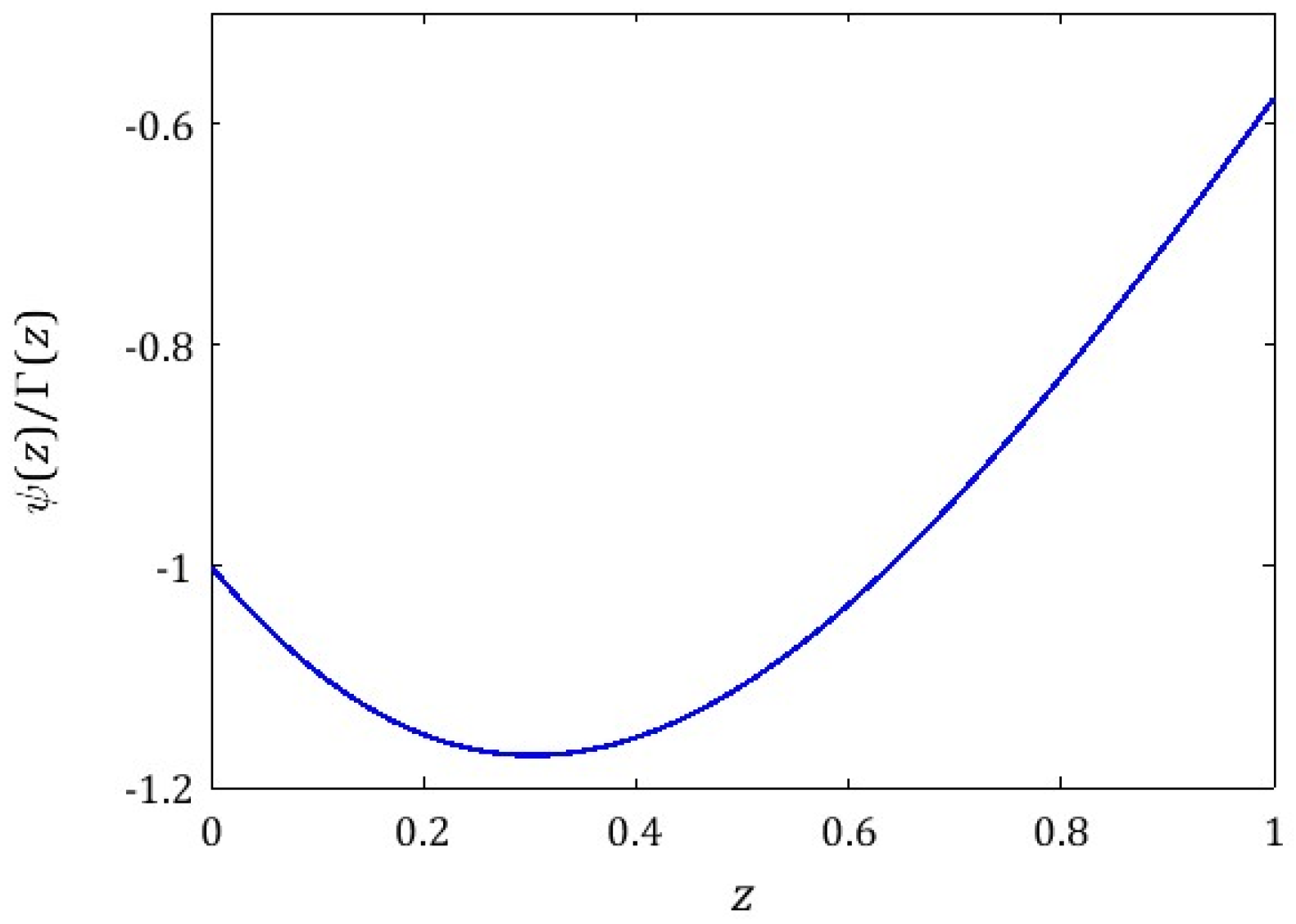
Appendix B
Appendix B.1. The Results of the Numerical Studies for Material I
| 50 | 9.295186 × 10−5 | 2.102093 × 10−3 | 2.863765 × 10−3 | 0.527 | 0.963788 | 8.644275 × 10−2 | 2.862573 | 15.170858 |
| 100 | 5.614324 × 10−4 | 5.907274 × 10−5 | 1.350707 × 10−3 | 1.224 | 0.965614 | 7.207174 × 10−2 | 2.745219 | 16.225154 |
| 200 | 2.185904 × 10−4 | 1.109724 × 10−4 | 4.959376 × 10−3 | 4.537 × 10−3 | 0.954725 | 8.815551 × 10−2 | 3.065976 | 14.289093 |
| 500 | 5.559271 × 10−4 | 5.053629 × 10−5 | 5.262647 × 10−4 | 7.740 × 10−3 | 0.915232 | 1.261495 × 10−2 | 3.113879 | 12.68090 |
| 1000 | 4.594139 × 10−4 | 1.476206 × 10−4 | 5.268387 × 10−4 | 3.104 × 10−4 | 0.920937 | 1.341017 × 10−2 | 3.081285 | 12.926718 |
| 2000 | 4.668059 × 10−4 | 3.243456 × 10−6 | 5.396114 × 10−4 | 5.315 × 10−2 | 0.929099 | 2.375304 × 10−2 | 3.015563 | 13.557098 |
| 5000 | 5.289533 × 10−4 | 3.282759 × 10−7 | 5.213213 × 10−4 | 2.876 × 10−4 | 0.920502 | 1.445854 × 10−2 | 3.081489 | 12.984136 |
| 7000 | 5.224292 × 10−4 | 3.978418 × 10−6 | 5.215398 × 10−4 | 1.654 × 10−4 | 0.920364 | 1.419721 × 10−2 | 3.082754 | 12.979817 |
| 10,000 | 5.082251 × 10−4 | 3.739909 × 10−6 | 5.219846 × 10−4 | 9.301 × 10−5 | 0.920327 | 1.391317 × 10−2 | 3.083746 | 12.942422 |
| 12,000 | 5.150186 × 10−4 | 1.363350 × 10−5 | 5.208965 × 10−4 | 1.689 × 10−5 | 0.920187 | 1.504288 × 10−2 | 3.085455 | 12.942422 |
| 15,000 | 5.247854 × 10−4 | 3.687418 × 10−6 | 5.205439 × 10−4 | 1.938 × 10−8 | 0.920014 | 1.472034 × 10−2 | 3.086680 | 12.949456 |
| 50 | 1.246174 × 10−4 | 3.1182072 × 10−3 | 2.953417 × 10−3 | 0.501 | 0.962059 | 8.720788 × 10−2 | 2.868287 | 15.170858 |
| 100 | 6.042548 × 10−4 | 9.788569 × 10−3 | 9.505292 × 10−4 | 0.542 | 0.950711 | 5.528005 × 10−2 | 2.859441 | 15.193338 |
| 200 | 2.469407 × 10−4 | 2.622478 × 10−4 | 4.888504 × 10−3 | 3.999 × 10−3 | 0.954563 | 8.747687 × 10−2 | 3.067250 | 14.289093 |
| 500 | 5.754599 × 10−4 | 1.136117 × 10−7 | 5.288353 × 10−4 | 1.1543 × 10−4 | 0.917799 | 1.594113 × 10−2 | 3.090037 | 12.837417 |
| 1000 | 4.8724914 × 10−4 | 6.769619 × 10−4 | 5.261736 × 10−4 | 2.129 × 10−4 | 0.921142 | 1.374989 × 10−2 | 3.082219 | 12.926718 |
| 2000 | 4.8687842 × 10−4 | 3.040833 × 10−7 | 5.400918 × 10−4 | 5.345 × 10−2 | 0.929234 | 2.394509 × 10−2 | 3.015365 | 13.557098 |
| 5000 | 5.4973567 × 10−4 | 3.940686 × 10−6 | 5.211862 × 10−4 | 3.026 × 10−4 | 0.920472 | 1.459525 × 10−2 | 3.081354 | 12.984135 |
| 7000 | 5.401956 × 10−4 | 1.559930 × 10−6 | 5.214093 × 10−4 | 1.573 × 10−4 | 0.920350 | 1.428889 × 10−2 | 3.082852 | 12.979817 |
| 10,000 | 5.261243 × 10−4 | 2.744246 × 10−6 | 5.221499 × 10−4 | 5.516 × 10−4 | 0.920905 | 1.446157 × 10−2 | 3.079473 | 12.979817 |
| 12,000 | 5.356062 × 10−4 | 5.782985 × 10−5 | 5.208668 × 10−4 | 2.386 × 10−5 | 0.920122 | 1.495904 × 10−2 | 3.085216 | 12.942422 |
| 15,000 | 5.457918 × 10−4 | 4.535517 × 10−6 | 5.205517 × 10−4 | 2.513 × 10−7 | 0.919980 | 1.477095 × 10−2 | 3.086569 | 12.949456 |
| 50 | 1.823164 × 10−4 | 4.314509 × 10−3 | 2.993805 × 10−3 | 0.504 | 0.961565 | 8.769949 × 10−2 | 2.867641 | 15.1708579 |
| 100 | 6.647523 × 10−4 | 0.353591 | 9.411604 × 10−4 | 0.517 | 0.949857 | 5.428199 × 10−2 | 2.864822 | 15.193338 |
| 200 | 2.961081 × 10−4 | 4.334879 × 10−4 | 4.686224 × 10−3 | 4.277 × 10−3 | 0.954203 | 8.597868 × 10−2 | 3.066582 | 14.289093 |
| 500 | 6.078210 × 10−4 | 2.946700 × 10−5 | 5.271033 × 10−4 | 3.193 × 10−4 | 0.918084 | 1.579814 × 10−2 | 3.092238 | 12.837417 |
| 1000 | 5.328032 × 10−4 | 2.789884 × 10−3 | 5.267889 × 10−4 | 1.300 × 10−4 | 0.921325 | 1.356372 × 10−2 | 3.083203 | 12.926718 |
| 2000 | 5.248407 × 10−4 | 3.026647 × 10−7 | 5.403471 × 10−4 | 5.202 × 10−2 | 0.929297 | 2.403479 × 10−2 | 3.016320 | 13.557098 |
| 5000 | 5.883023 × 10−4 | 1.431097 × 10−5 | 5.210845 × 10−4 | 3.179 × 10−4 | 0.920442 | 1.473303 × 10−2 | 3.081219 | 12.984135 |
| 7000 | 5.759879 × 10−4 | 1.780341 × 10−7 | 5.220610 × 10−4 | 2.087 × 10−3 | 0.921658 | 1.538542 × 10−2 | 3.072622 | 13.066791 |
| 10,000 | 5.616302 × 10−4 | 2.127802 × 10−6 | 5.220589 × 10−4 | 5.578 × 10−4 | 0.920855 | 1.448935 × 10−2 | 3.079433 | 12.979817 |
| 12,000 | 5.739756 × 10−4 | 2.163690 × 10−4 | 5.211071 × 10−4 | 8.574 × 10−4 | 0.921109 | 1.594595 × 10−2 | 3.077685 | 13.006321 |
| 15,000 | 5.843841 × 10−4 | 5.116492 × 10−6 | 5.207537 × 10−4 | 4.857 × 10−4 | 0.920823 | 1.552819 × 10−2 | 3.079921 | 13.006321 |
Appendix B.2. The Results of the Numerical Studies for Material II
| 50 | 1.315712 × 10−5 | 3.597318 × 10−7 | 5.638335 × 10−5 | 2.342 | 0.677682 | 6.870627 × 10−2 | 1.370585 | 5.418555 × 103 |
| 100 | 1.161929 × 10−5 | 5.298049 × 10−7 | 4.939762 × 10−5 | 4.151 | 0.656134 | 6.493121 × 10−2 | 1.409899 | 5.094185 × 103 |
| 200 | 1.03161 × 10−5 | 1.124491 × 10−8 | 5.287861 × 10−5 | 4.759 | 0.65004 | 6.373051 × 10−2 | 1.421409 | 5.002011 × 103 |
| 500 | 9.772230 × 10−6 | 2.140316 × 10−8 | 2.966257 × 10−5 | 0.897 | 0.686475 | 7.329572 × 10−2 | 1.336261 | 5.791700 × 103 |
| 1000 | 1.216504 × 10−5 | 1.472521 × 10−8 | 2.964808 × 10−5 | 0.847 | 0.691723 | 7.332173 × 10−2 | 1.331643 | 5.808836 × 103 |
| 2000 | 9.462435 × 10−6 | 2.397636 × 10−9 | 3.703687 × 10−5 | 1.928 | 0.674709 | 6.955942 × 10−2 | 1.364964 | 5.509183 × 103 |
| 5000 | 3.372717 × 10−5 | 1.236704 × 10−8 | 2.439945 × 10−5 | 0.061 | 0.750336 | 8.307524 × 10−2 | 1.245023 | 6.555588 × 103 |
| 7000 | 3.499392 × 10−5 | 3.0361484 × 10−9 | 2.578132 × 10−5 | 0.179 | 0.761153 | 8.483605 × 10−2 | 1.231209 | 6.669047 × 103 |
| 10,000 | 3.974638 × 10−5 | 1.327619 × 10−9 | 2.524376 × 10−5 | 0.136 | 0.757999 | 8.429268 × 10−2 | 1.235341 | 6.633616 × 103 |
| 12,000 | 3.289041 × 10−5 | 2.540537 × 10−10 | 2.384835 × 10−5 | 1.384 × 10−3 | 0.735839 | 8.062010 × 10−2 | 1.265447 | 6.373837 × 103 |
| 15,000 | 3.259757 × 10−5 | 2.789747 × 10−10 | 2.383509 × 10−5 | 6.536 × 10−5 | 0.737489 | 8.098389 × 10−2 | 1.262561 | 6.402808 × 103 |
| 50 | 5.334837 × 10−5 | 1.607199 × 10−6 | 5.383509 × 10−5 | 1.783 | 0.691583 | 7.062629 × 10−2 | 1.352647 | 5.543339 × 103 |
| 100 | 4.625811 × 10−5 | 1.912785 × 10−6 | 5.226179 × 10−5 | 4.853 | 0.652363 | 6.407151 × 10−2 | 1.421237 | 4.988252 × 103 |
| 200 | 4.104462 × 10−5 | 6.4067158 × 10−8 | 6.964808 × 10−5 | 7.841 | 0.632293 | 5.905374 × 10−2 | 1.467987 | 4.606199 × 103 |
| 500 | 3.664178 × 10−5 | 7.819189 × 10−8 | 3.074233 × 10−5 | 1.039 | 0.681071 | 7.285674 × 10−2 | 1.342891 | 5.745449 × 103 |
| 1000 | 3.879589 × 10−5 | 6.729167 × 10−8 | 2.961505 × 10−5 | 0.869 | 0.689812 | 7.328929 × 10−2 | 1.333233 | 5.801105 × 103 |
| 2000 | 3.618881 × 10−5 | 1.385717 × 10−9 | 3.604767 × 10−5 | 1.786 | 0.675299 | 6.992477 × 10−2 | 1.362099 | 5.542684 × 103 |
| 5000 | 5.999448 × 10−5 | 3.264396 × 10−8 | 2.456599 × 10−5 | 8.109 × 10−2 | 0.752093 | 8.335898 × 10−2 | 1.242558 | 6.579817 × 103 |
| 7000 | 6.106792 | 5.065819 × 10−9 | 2.598612 × 10−5 | 0.195 | 0.763258 | 8.506666 × 10−2 | 1.229229 | 6.680137 × 103 |
| 10,000 | 6.592012 × 10−5 | 1.717204 × 10−9 | 2.536338 × 10−5 | 0.144 | 0.759401 | 8.444666 × 10−2 | 1.234044 | 6.640191 × 103 |
| 12,000 | 5.916358 × 10−5 | 2.831521 × 10−9 | 2.384641 × 10−5 | 5.855 × 10−4 | 0.737150 | 8.077941 × 10−2 | 1.264056 | 6.382156 × 103 |
| 15,000 | 5.893401 × 10−5 | 1.984301 × 10−10 | 2.384002 × 10−5 | 2.644 × 10−4 | 0.738283 | 8.108685 × 10−2 | 1.261701 | 6.408038 × 103 |
| 50 | 9.520744 × 10−5 | 2.941612 × 10−6 | 6.384002 × 10−5 | 1.448 | 0.701586 | 7.198997 × 10−2 | 1.340251 | 5.627729 × 103 |
| 100 | 8.218302 × 10−5 | 3.329357 × 10−6 | 5.485285 × 10−5 | 5.348 | 0.649888 | 6.349515 × 10−2 | 1.428867 | 4.918087 × 103 |
| 200 | 7.290485 × 10−5 | 1.233057 × 10−7 | 8.330015 × 10−5 | 10.352 | 0.620745 | 5.578770 × 10−2 | 1.501144 | 4.339259 × 103 |
| 500 | 6.446603 × 10−5 | 1.355064 × 10−7 | 3.166061 × 10−5 | 1.145 | 0.677484 | 7.255754 × 10−2 | 1.347428 | 5.713136 × 103 |
| 1000 | 6.646278 × 10−5 | 1.240244 × 10−7 | 2.966288 × 10−5 | 0.885 | 0.688528 | 7.326539 × 10−2 | 1.334319 | 5.795691 × 103 |
| 2000 | 6.395292 × 10−5 | 2.673029 × 10−9 | 3.542823 × 10−5 | 1.693 | 0.675699 | 7.016833 × 10−2 | 1.360185 | 5.565162 × 103 |
| 5000 | 8.738813 × 10−5 | 5.134265 × 10−8 | 2.469399 × 10−5 | 9.607 × 10−2 | 0.753278 | 8.354811 × 10−2 | 1.240915 | 6.595934 × 103 |
| 7000 | 8.835062 × 10−5 | 6.705427 × 10−9 | 2.613160 × 10−5 | 0.205 | 0.764677 | 8.522041 × 10−2 | 1.227913 | 6.687353 × 103 |
| 10,000 | 9.319389 × 10−5 | 2.003354 × 10−9 | 2.544649 × 10−5 | 0.149 | 0.760331 | 8.454841 × 10−2 | 1.233188 | 6.644512 × 103 |
| 12,000 | 8.640779 × 10−5 | 6.119895 × 10−9 | 2.384921 × 10−5 | 2.494 × 10−4 | 0.738014 | 8.088431 × 10−2 | 1.263145 | 6.387532 × 103 |
| 15,000 | 8.625405 × 10−5 | 1.518245 × 10−10 | 2.384484 × 10−5 | 4.544 × 10−4 | 0.738792 | 8.115159 × 10−2 | 1.261157 | 6.411273 × 103 |
References
- Gorenflo, R.; Kilbas, A.A.; Mainardi, F.; Rogosin, S.V. Mittag-Leffler Functions, Related Topics and Applications; Springer: Berlin/Heidelberg, Germany, 2014. [Google Scholar] [CrossRef]
- Schiessel, H.; Metzler, R.; Blumen, A.; Nonnejunacher, T.F. Generalized viscoelastic models: Their fractional equations with solutions. J. Phys. A Math. Gen. 1995, 28, 6567–6584. [Google Scholar] [CrossRef]
- Metzler, R.; Nonnenmacher, T.F. Fractional relaxation processes and fractional rheological models for the description of a class of viscoelastic materials. Int. J. Plast. 2003, 19, 941–959. [Google Scholar] [CrossRef]
- Mainardi, F. Fractional Calculus and Waves in Linear Viscoelasticity: An Introduction to Mathematical Models; World Scientific: Hackensack, NJ, USA, 2022. [Google Scholar]
- Mainardi, F.; Spada, G. Creep, Relaxation and Viscosity Properties for Basic Fractional Models in Rheology. Eur. Phys. J. Spec. Top. 2011, 193, 133–160. [Google Scholar] [CrossRef]
- Meng, R.; Yin, D.; Drapaca, C.S. A variable order fractional constitutive model of the viscoelastic behavior of polymers. Int. J. Non-Linear Mech. 2019, 113, 171–177. [Google Scholar] [CrossRef]
- Shiru, G.; Hai, P.; Mengsen, Y.; Ziheng, S.; Dejun, L.; Jinyong, X.; Yiying, F. New perspective on the creep characteristic of fiber–dependent shape memory polymers: Variable–order fractional constitutive model. J. Mater. Res. Technol. 2023, 24, 5177–5185. [Google Scholar] [CrossRef]
- Liang, Z.; Li, J.; Zhang, X.; Kan, Q. A viscoelastic-viscoplastic constitutive model and its finite element implementation of amorphous polymers. Polym. Test. 2023, 117, 107831. [Google Scholar] [CrossRef]
- Xu, B.; Blok, R.; Teuffel, P. An investigation of the effect of relative humidity on viscoelastic properties of flax fiber reinforced polymer by fractional-order viscoelastic model. Compos. Commun. 2023, 37, 101406. [Google Scholar] [CrossRef]
- Viviani, L.; Di Paola, M.; Royer-Carfagni, G. Fractional viscoelastic modeling of laminated glass beams in the pre-crack state under explosive loads. Int. J. Solids Struct. 2022, 248, 111617. [Google Scholar] [CrossRef]
- Xiang, G.; Yin, D.; Meng, R.; Cao, C. Predictive model for stress relaxation behavior of glassy polymers based on variable-order fractional calculus. Polym. Adv. Technol. 2021, 32, 703–713. [Google Scholar] [CrossRef]
- Popov, I.I.; Shitikova, M.V.; Levchenko, A.V.; Zhukov, A.D. Experimental identification of the fractional parameter of the fractional derivative standard linear solid model for fiber-reinforced rubber concrete. Mech. Adv. Mater. Struct. 2023, 1–9. [Google Scholar] [CrossRef]
- Hajikarimi, P.; Ehsani, M.; EL Haloui, Y.; Tehrani, F.F.; Absi, J.; Nejad, F.M. Fractional viscoelastic modeling of modified asphalt mastics using response surface method. Constr. Build. Mater. 2022, 317, 125958. [Google Scholar] [CrossRef]
- Cai, W.; Wang, P. Rate-dependent fractional constitutive model for nonlinear behaviors of rubber polymers. Eur. J. Mech. A/Solids 2024, 103, 105186. [Google Scholar] [CrossRef]
- David, S.A.; Katayama, A.H. Fractional Order for Food Gums: Modeling and Simulation. Appl. Math. 2013, 4, 28194. [Google Scholar] [CrossRef]
- Stankiewicz, A. Fractional Maxwell model of viscoelastic biological materials. BIO Web Conf. 2018, 10, 02032. [Google Scholar] [CrossRef]
- Bainy, E.M.; Lenzi, E.K.; Corazza, M.L.; Lenzi, M.K. Mathematical Modeling of Fish Burger Baking Using Fractional Calculus. Therm. Sci. 2017, 21, 41–50. [Google Scholar] [CrossRef]
- Lei, D.; Liang, Y.; Xiao, R. A fractional model with parallel fractional Maxwell elements for amorphous thermoplastics. Phys. A Stat. Mech. Its Appl. 2018, 490, 465–475. [Google Scholar] [CrossRef]
- Hou, T.; Chen, H. Isothermal physical aging of PEEK and PPS investigated by fractional Maxwell model. Polymer 2012, 53, 2509–2518. [Google Scholar] [CrossRef]
- Elmoghazy, Y.H.; Safaei, B.; Asmael, M.; Sahmani, S.; Zeeshan, Q.; Qin, Z. Computational Modelling and Analysis of Effect of Viscoelastic Materials on Damping and Vibrational Behaviors of Composite Structures—An Extensive Review. Arch. Computat. Methods Eng. 2024, 1–52. [Google Scholar] [CrossRef]
- Gritsenko, D.; Paoli, R. Theoretical Analysis of Fractional Viscoelastic Flow in Circular Pipes: General Solutions. Appl. Sci. 2020, 10, 9093. [Google Scholar] [CrossRef]
- Loglio, G.; Kovalchuk, V.I.; Bykov, A.G.; Ferrari, M.; Krägel, J.; Liggieri, L.; Miller, R.; Noskov, B.A.; Pandolfini, P.; Ravera, F.; et al. Interfacial Dilational Viscoelasticity of Adsorption Layers at the Hydrocarbon/Water Interface: The Fractional Maxwell Model. Colloids Interfaces 2019, 3, 66. [Google Scholar] [CrossRef]
- Kovalchuk, V.I.; Loglio, G.; Bykov, A.G.; Ferrari, M.; Krägel, J.; Liggieri, L.; Miller, R.; Milyaeva, O.Y.; Noskov, B.A.; Ravera, F.; et al. Effect of Temperature on the Dynamic Properties of Mixed Surfactant Adsorbed Layers at the Water/Hexane Interface under Low-Gravity Conditions. Colloids Interfaces 2020, 4, 27. [Google Scholar] [CrossRef]
- Mao, B.; Zhu, R.; Wang, Z.; Yang, Y.; Han, X.; Zhao, Q. A Modified Fractional Maxwell Numerical Model for Constitutive Equation of Mn-Cu Damping Alloy. Materials 2020, 13, 2020. [Google Scholar] [CrossRef]
- Schmidt, A.; Gaul, L. Parameter Identification and FE Implementation of a Viscoelastic Constitutive Equation Using Fractional Derivatives. Proc. Appl. Math. Mech. 2002, 1, 153–154. [Google Scholar] [CrossRef]
- Xiao, Z.; Haitian, Y.; Yiqian, F. Identification of constitutive parameters for fractional viscoelasticity. Commun. Nonlinear Sci. Numer. Simul. 2014, 19, 311–322. [Google Scholar] [CrossRef]
- Zhou, H.W.; Yi, H.Y.; Mishnaevsky, L.; Wang, R.; Duan, Z.Q.; Chen, Q. Deformation analysis of polymers composites: Rheological model involving time-based fractional derivative. Mech. Time-Depend. Mater. 2017, 21, 151–161. [Google Scholar] [CrossRef]
- Zhou, S.; Cao, J.; Chen, Y. Genetic Algorithm-Based Identification of Fractional-Order Systems. Entropy 2013, 15, 1624–1642. [Google Scholar] [CrossRef]
- Lewandowski, R.; Chorążyczewski, B. Identification of the parameters of the Kelvin–Voigt and the Maxwell fractional models, used to modeling of viscoelastic dampers. Comput. Struct. 2010, 88, 1–17. [Google Scholar] [CrossRef]
- Beda, T.; Chevalier, Y. New Methods for Identifying Rheological Parameter for Fractional Derivative Modeling of Viscoelastic Behavior. Mech. Time-Depend. Mater. 2004, 8, 105–118. [Google Scholar] [CrossRef]
- Yin, Y.; Yang, Z.; Shi, M. Circular arc rules of complex plane plot for model parameters determination of viscoelastic material. Mech. Time-Depend. Mater. 2021, 25, 631–643. [Google Scholar] [CrossRef]
- Ljung, L. System Identification: Theory for the User, 1st ed.; Prentice Hall: Englewood Cliffs, NJ, USA, 1999. [Google Scholar]
- Stankiewicz, A.; Juściński, S. How to Make the Stress Relaxation Experiment for Polymers More Informative. Polymers 2023, 15, 4605. [Google Scholar] [CrossRef]
- Ljung, L. Convergence analysis of parametric identification methods. IEEE Trans. Autom. Control 1978, 23, 770–783. [Google Scholar] [CrossRef]
- Hasiewicz, Z.; Stankiewicz, A. On input-dependent system identification by Monte Carlo approach. IEEE Trans. Autom. Control 1986, 31, 192, Erratum in IEEE Trans. Autom. Control 1985, 30, 480–483. [Google Scholar] [CrossRef]
- Apelblat, A. Differentiation of the Mittag-Leffler Functions with Respect to Parameters in the Laplace Transform Approach. Mathematics 2020, 8, 657. [Google Scholar] [CrossRef]
- Muzeau, E.; Perez, J.; Johari, G.P. Mechanical spectrometry of the beta-relaxation in poly(methyl methacrylate). Macromolecules 1991, 24, 4713–4723. [Google Scholar] [CrossRef]
- Carrillo-Navas, H.; Hernández-Jaimes, C.; Utrilla-Coello, R.G.; Meraz, M.; Vernon-Carter, E.J.; Alvarez-Ramirez, J. Viscoelastic relaxation spectra of some native starch gels. Food Hydrocoll. 2014, 37, 25–33. [Google Scholar] [CrossRef]
- Wang, J.; Wang, X.; Ruan, H. On the mechanical β relaxation in glass and its relation to the double-peak phenomenon in impulse excited vibration at high temperatures. J. Non-Cryst. Solids 2020, 533, 119939. [Google Scholar] [CrossRef]
- Baumgaertel, M.; Schausberger, A.; Winter, H.H. The relaxation of polymers with linear flexible chains of uniform length. Rheol. Acta 1990, 29, 400–408. [Google Scholar] [CrossRef]
- Baumgaertel, M.; Winter, H.H. Interrelation between continuous and discrete relaxation time spectra. J. Non-Newton. Fluid Mech. 1992, 44, 15–36. [Google Scholar] [CrossRef]
- Cho, K.S. Power series approximations of dynamic moduli and relaxation spectrum. J. Rheol. 2013, 57, 679–697. [Google Scholar] [CrossRef]
- Lee, S.H.; Bae, J.-E.; Cho, K.S. Determination of continuous relaxation spectrum based on the Fuoss-Kirkwood relation and logarithmic orthogonal power-series approximation. Korea-Aust. Rheol. J. 2017, 29, 115–127. [Google Scholar] [CrossRef]
- Ferry, J.D. Viscoelastic Properties of Polymers, 3rd ed.; John Wiley & Sons: New York, NY, USA, 1980. [Google Scholar]
- Gorenflo, R.; Mainardi, F. Fractional Calculus: Integral and Differential Equations of Fractional Order. In Fractals and Fractional Calculus in Continuum Mechanics; Carpinteri, A., Mainardi, F., Eds.; Springer: Wien, Austria; New York, NY, USA, 1997; pp. 223–276. [Google Scholar]
- Malkin, A.I.A.; Malkin, A.Y.; Isayev, A.I. Rheology: Concepts, Methods and Applications; ChemTec: Deerfield Beach, FL, USA, 2006; Available online: https://books.google.pl/books?id=8rGafjhgz-UC (accessed on 5 April 2023).
- Stankiewicz, A. On Applicability of the Relaxation Spectrum of Fractional Maxwell Model to Description of Unimodal Relaxation Spectra of Polymers. Polymers 2023, 15, 3552. [Google Scholar] [CrossRef] [PubMed]
- Pérez-Calixto, D.; Amat-Shapiro, S.; Zamarrón-Hernández, D.; Vázquez-Victorio, G.; Puech, P.-H.; Hautefeuille, M. Determination by Relaxation Tests of the Mechanical Properties of Soft Polyacrylamide Gels Made for Mechanobiology Studies. Polymers 2021, 13, 629. [Google Scholar] [CrossRef] [PubMed]
- Andrei, N. Modern Numerical Nonlinear Optimization; Springer: Cham, Switzerland, 2022. [Google Scholar] [CrossRef]
- Hoeffding, W. Probability inequalities for sums of bounded random variables. J. Am. Stat. Assoc. 1963, 58, 13–30. [Google Scholar] [CrossRef]
- Kwakye-Nimo, S.; Inn, Y.; Yu, Y.; Wood-Adams, P.M. Linear viscoelastic behavior of bimodal polyethylene. Rheol. Acta 2022, 61, 373–386. [Google Scholar] [CrossRef]
- Cirillo, G.; Spizzirri, U.G.; Iemma, F. Functional Polymers in Food Science: From Technology to Biology, Volume 1: Food Packaging; Wiley: New York, NY, USA, 2015; Available online: https://onlinelibrary.wiley.com/doi/book/10.1002/9781119108580 (accessed on 20 June 2023).
- Lorenzo, G.; Checmarev, G.; Zaritzky, N.; Califano, A. Linear viscoelastic assessment of cold gel-like emulsions stabilized with bovine gelatin. LWT Food Sci. Technol. 2011, 44, 457–464. [Google Scholar] [CrossRef]
- Bardet, S.; Gril, J. Modelling the transverse viscoelasticity of green wood using a combination of two parabolic elements. C. R. Mec. 2002, 330, 549–556. [Google Scholar] [CrossRef]
- Kurenuma, Y.; Nakano, T. Analysis of stress relaxation on the basis of isolated relaxation spectrum for wet wood. J. Mater. Sci. 2012, 47, 4673–4679. [Google Scholar] [CrossRef]
- Choi, J.; Cho, K.S.; Kwon, M.K. Self-Similarity and Power-Law Spectra of Polymer Melts and Solutions. Polymers 2022, 14, 3924. [Google Scholar] [CrossRef]
- Unidad, H.J.; Goad, M.A.; Bras, A.R.; Zamponi, M.; Faust, R.; Allgaier, J.; Pyckhout-Hintzen, W.; Wischnewski, A.; Richter, D.; Fetters, L.J. Consequences of Increasing Packing Length on the Dynamics of Polymer Melts. Macromolecules 2015, 48, 6638–6645. [Google Scholar] [CrossRef]
- Podlubny, I. Fitting Data Using the Mittag-Leffler Function. MATLAB Central File Exchange. Available online: https://www.mathworks.com/matlabcentral/fileexchange/32170-fitting-data-using-the-mittag-leffler-function (accessed on 23 July 2023).
- Podlubny, I. Mittag-Leffler Function with Two Parameters. MATLAB Central File Exchange. Available online: https://www.mathworks.com/matlabcentral/fileexchange/8738-mittag-leffler-function (accessed on 23 July 2023).
- Stankiewicz, A. Two-Level Scheme for Identification of the Relaxation Time Spectrum Using Stress Relaxation Test Data with the Optimal Choice of the Time-ScaleFactor. Materials 2023, 16, 3565. [Google Scholar] [CrossRef]
- Stankiewicz, A. A Class of Algorithms for Recovery of Continuous Relaxation Spectrum from Stress Relaxation Test Data Using Orthonormal Functions. Polymers 2023, 15, 958. [Google Scholar] [CrossRef] [PubMed]
- Fikhtengol’ts, G.M. The Fundamentals of Mathematical Analysis; International Series of Monographs in Pure and Applied Mathematics; Pergamon Press: Oxford, UK; London, UK, 2013; Volume 2. [Google Scholar]
- Lemes, N.H.T.; dos Santos, J.P.C.; Braga, J.P. A generalized Mittag-Leffler function to describe nonexponential chemical effects. Appl. Math. Model. 2016, 40, 7971–7976. [Google Scholar] [CrossRef]
- Deming, W.; Colcord, C. The Minimum in the Gamma Function. Nature 1935, 135, 917. [Google Scholar] [CrossRef]
- Topsøe, F. Some bounds for the logarithmic function. In Inequality Theory and Applications; Cho, Y.J., Kim, J.K., Dragomir, S.S., Eds.; Nova Science Publishers: New York, NY, USA, 2007; p. 137. [Google Scholar]
- Alzer, H. On Some Inequalities for the Gamma and Psi Functions. Math. Comput. 1997, 66, 373–389. [Google Scholar] [CrossRef]
- Mező, I.; Hoffman, M.E. Zeros of the digamma function and its Barnes G-function analogue. Integral Transform. Spec. Funct. 2017, 28, 846–858. [Google Scholar] [CrossRef]
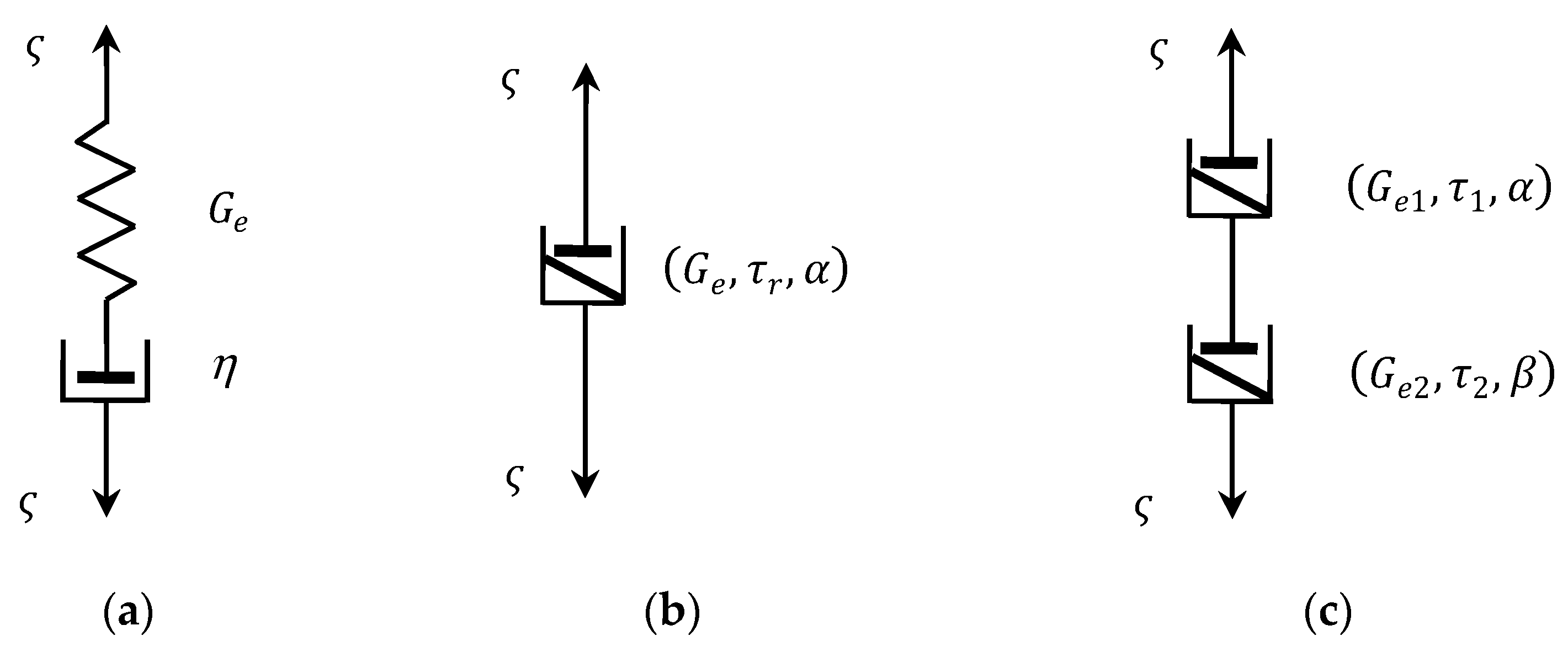
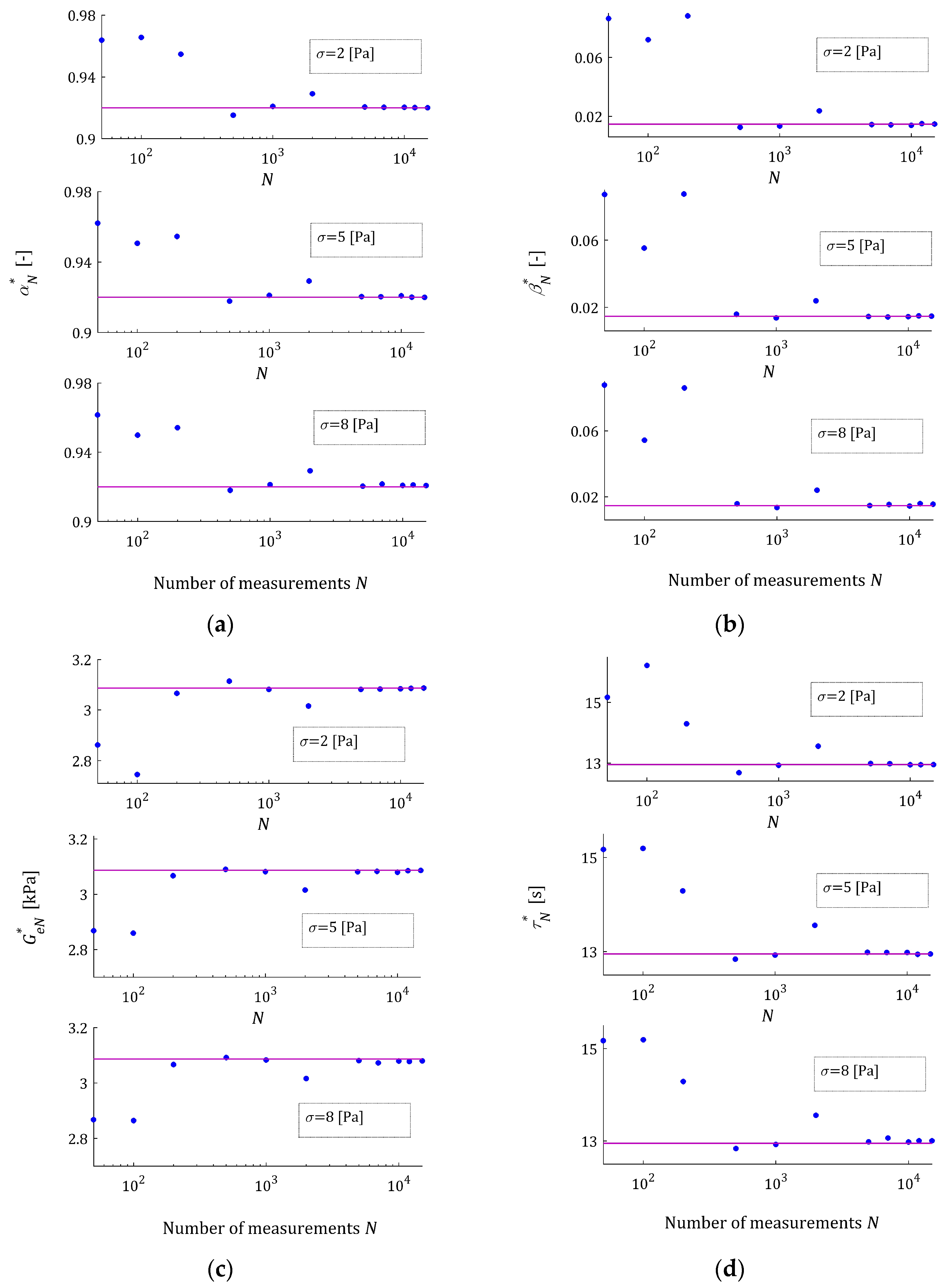

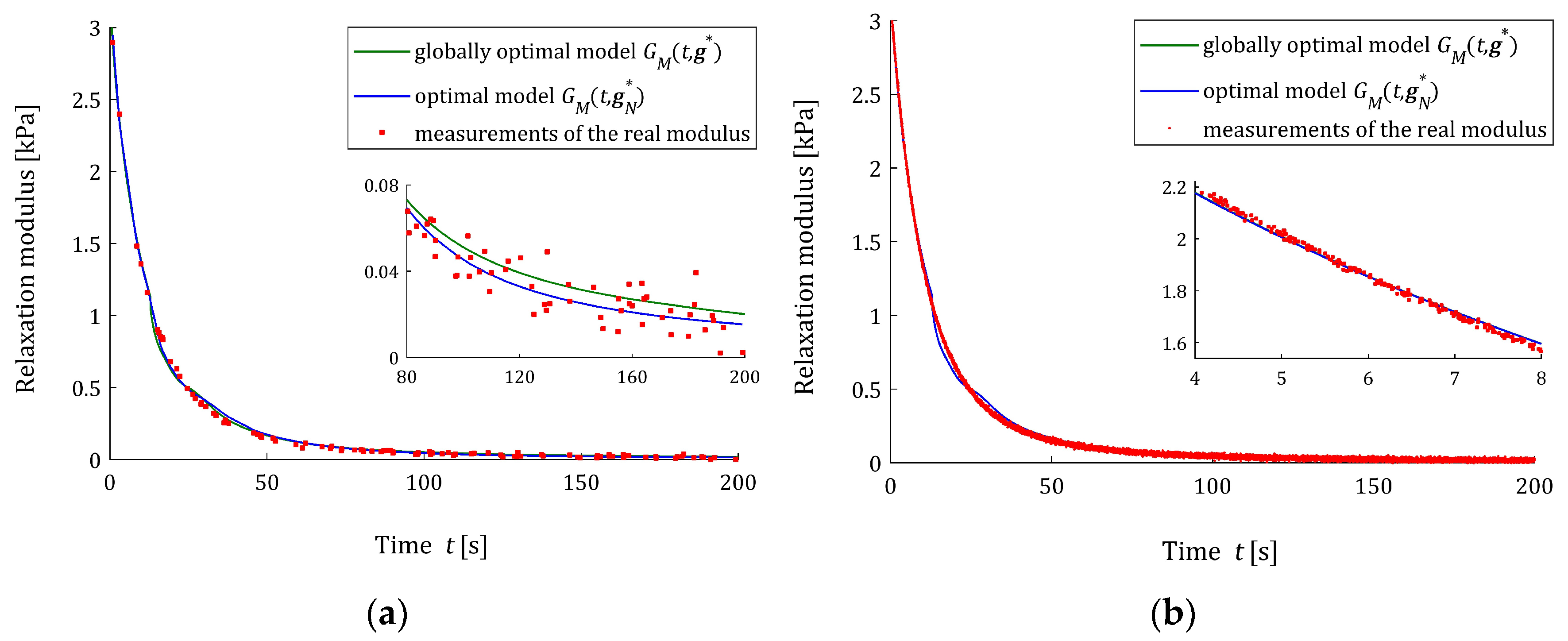
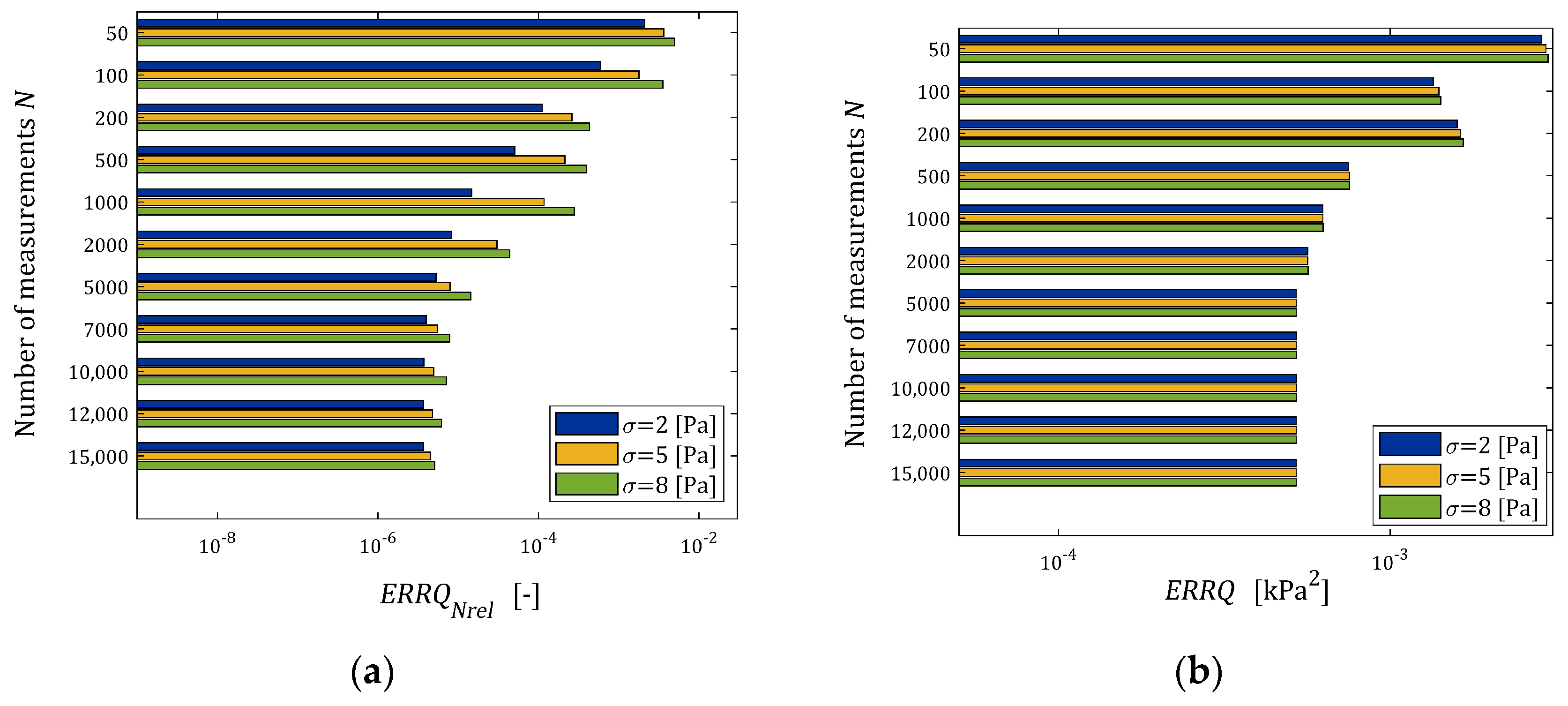
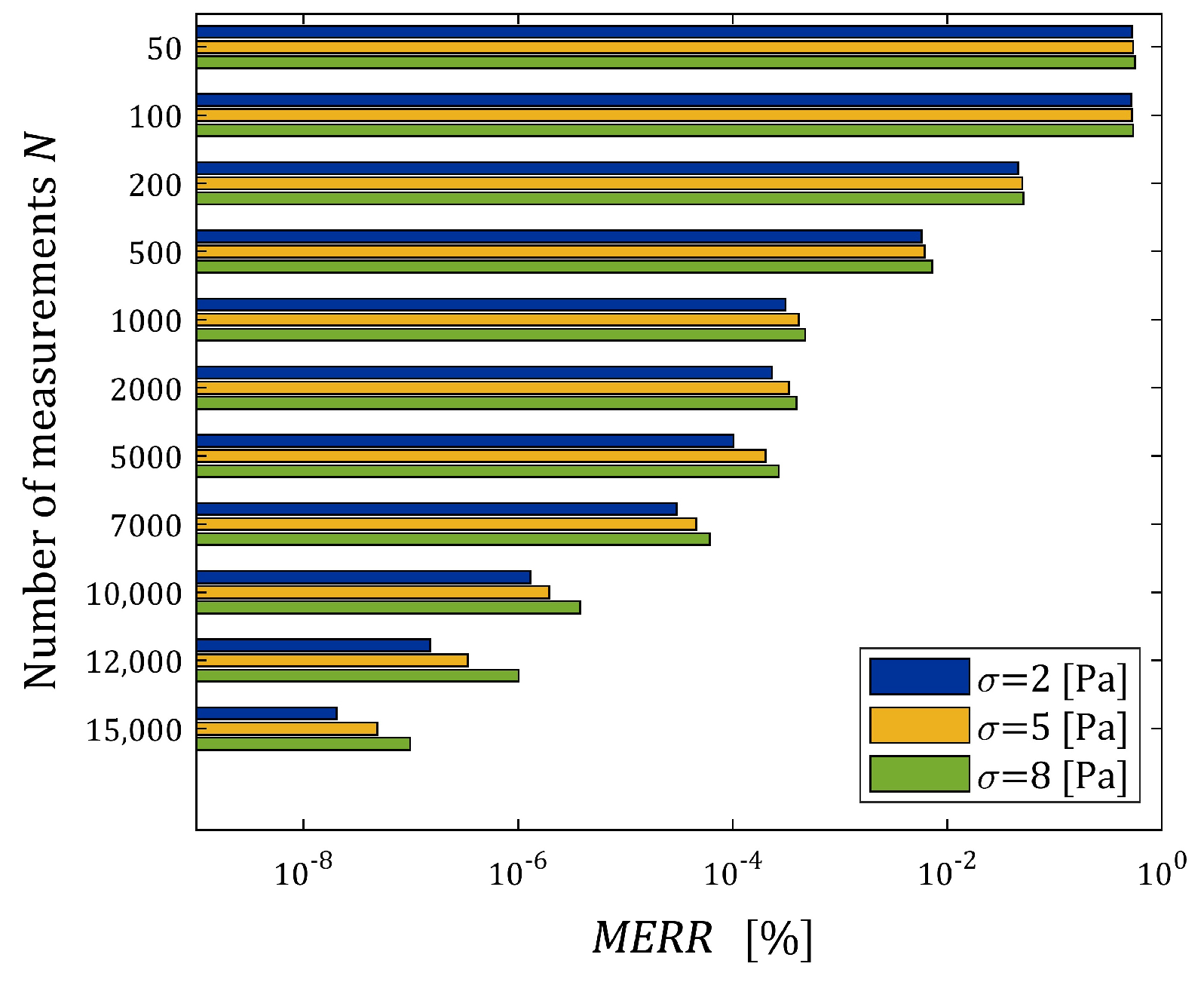
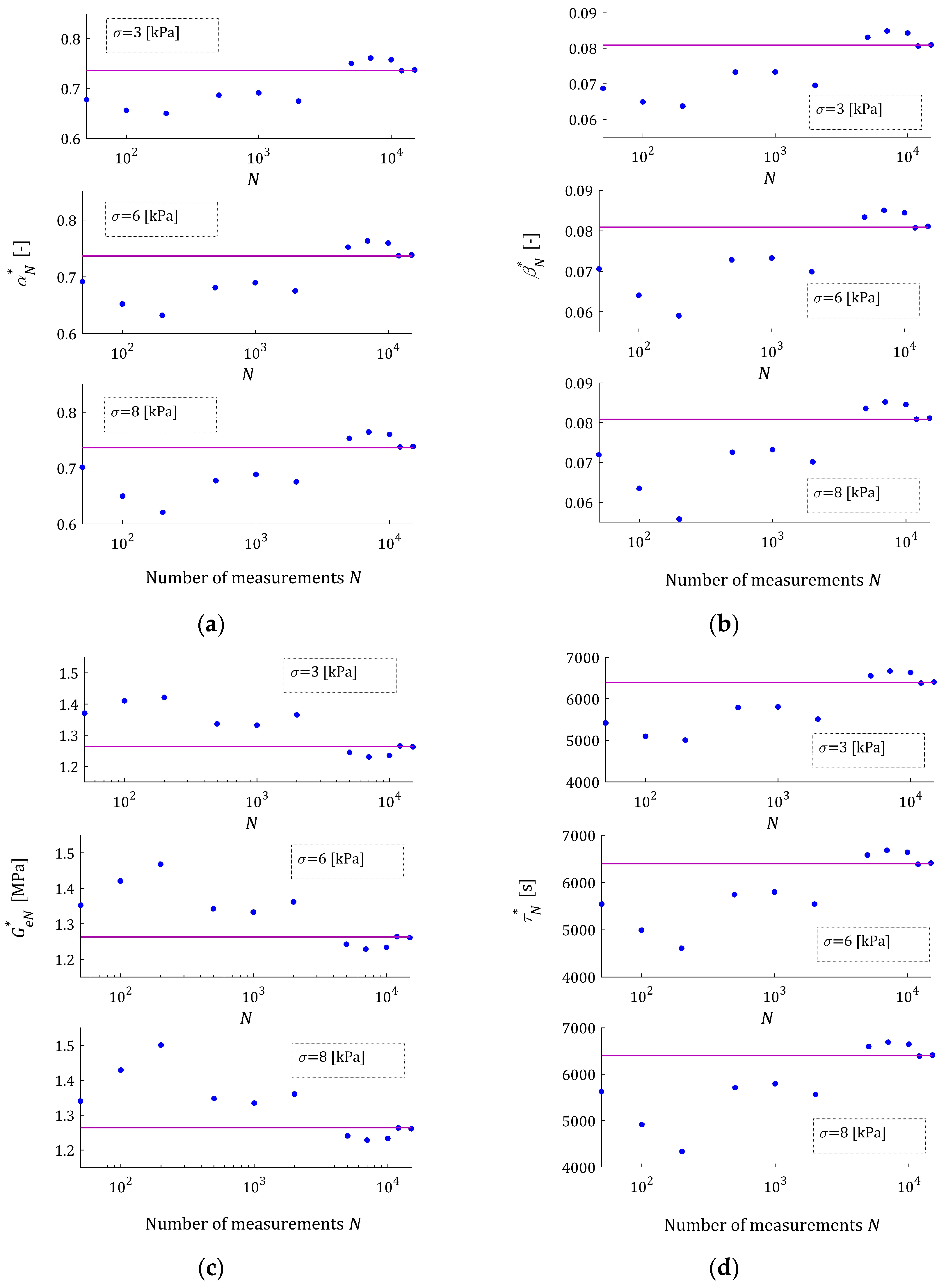


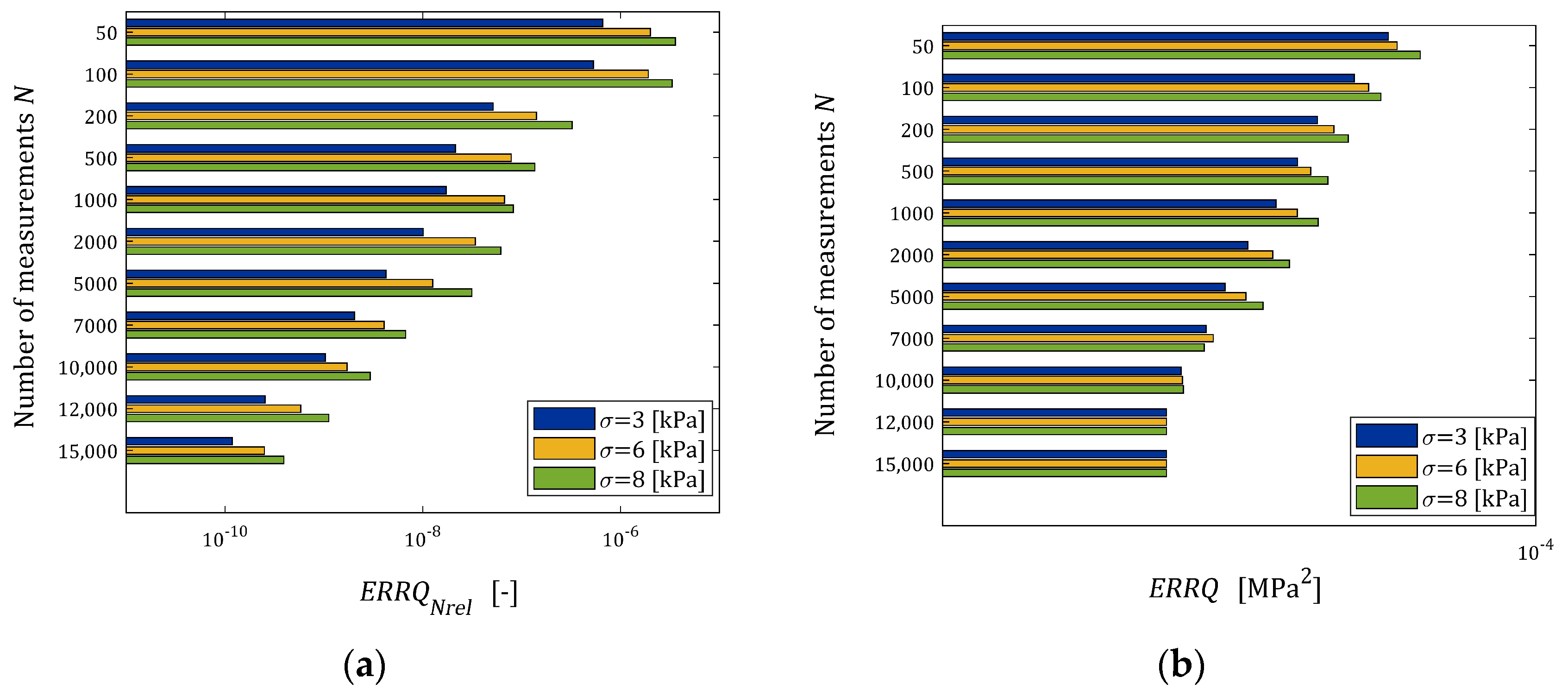

| 5.2054279 × 10−4 | 0.920029 | 1.469033 × 10−2 | 3.086723 | 12.949456 |
| 2.383349 × 10−5 | 0.736706 | 8.088257 × 10−2 | 1.2634125 | 6.397636 × 103 |
Disclaimer/Publisher’s Note: The statements, opinions and data contained in all publications are solely those of the individual author(s) and contributor(s) and not of MDPI and/or the editor(s). MDPI and/or the editor(s) disclaim responsibility for any injury to people or property resulting from any ideas, methods, instructions or products referred to in the content. |
© 2024 by the author. Licensee MDPI, Basel, Switzerland. This article is an open access article distributed under the terms and conditions of the Creative Commons Attribution (CC BY) license (https://creativecommons.org/licenses/by/4.0/).
Share and Cite
Stankiewicz, A. Sampling Points-Independent Identification of the Fractional Maxwell Model of Viscoelastic Materials Based on Stress Relaxation Experiment Data. Materials 2024, 17, 1527. https://doi.org/10.3390/ma17071527
Stankiewicz A. Sampling Points-Independent Identification of the Fractional Maxwell Model of Viscoelastic Materials Based on Stress Relaxation Experiment Data. Materials. 2024; 17(7):1527. https://doi.org/10.3390/ma17071527
Chicago/Turabian StyleStankiewicz, Anna. 2024. "Sampling Points-Independent Identification of the Fractional Maxwell Model of Viscoelastic Materials Based on Stress Relaxation Experiment Data" Materials 17, no. 7: 1527. https://doi.org/10.3390/ma17071527






